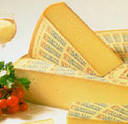Gruyère Swiss Mountain Cheese

Dating back to at least the 13th century, A.O.C. Farmhouse Gruyère is truly one of the great Swiss mountain cheeses.
In 2001 Switzerland received the Appellation D'Origine Contrôlée designation for Gruyère - a positive development because Gruyère-type cheeses are made in Germany and France, as well as in the U.S., Denmark and Austria.
When the day comes that Switzerland receives the European Union's Protected Designation of Origin (P.D.O.), then other countries will have to stop using the name Gruyère.
In any case, if judging Gruyère solely on a quality basis, the original Gruyère Swiss mountain cheese will always come out on top!
The pasteurized milk versions simply do not have the same nutty, rich flavor as the Swiss-made raw milk cheese.
Gruyère is a wonderful cheese to use in cooking, since it melts so beautifully - but it is also a cheese which deserves to be eaten by itself, in thin slivers or slices, one by one.
It also deserves inclusion on the cheese board, not just in the cooking pot!
Nutty Flavor
Gruyère has twice the flavor of Emmentaler, balanced between salt and sweet, with fruity and nutty undertones. It is rare to find any holes in Gruyère - it is made in such hygienic conditions that bacteria cannot thrive to produce the carbon dioxide which creates the holes.
Since it is aged longer (from 8-12 months and more) than Emmentaler, Gruyère has a denser texture, slightly crystalline, which dissolves quickly on the tongue.
The best nutty flavor comes from Gruyère which has been aged in caves for 12-24+ months.
The wheels are usually 38 inches in diameter and weigh 65-85 lbs.
The rind of top quality Gruyère will be brown and hard, with an off-white to yellow interior paste.
The Swiss call Gruyère "The grand old lady" and "The cheese that never gets tired," in reference to the fact that it is well-aged, keeps well and travels well.
It is the definitive Swiss mountain cheese.
Rolf Beeler
The cheese is made by groups of farmers in large
dairy cooperatives because each cheese requires over 88 gallons of raw
cow's milk to produce!
The raw milk (from two milkings) of black and white Fribourg cattle is used exclusively, and only copper pots may be used for preparation.
A great quantity of Gruyère is produced annually so it is well worth your while to seek out one of the best aged versions.
If you can find one with Rolf Beeler's imprint on the rind, be sure to buy it.
HOME › Swiss Cheese › Swiss Mountain Cheeses › Gruyère

Looking for something specific on GourmetCheeseDetective.com?
Enter your request below:
Follow The Gourmet Cheese Detective on Twitter: @The_Cheese_Tec
Make Your Investigation of Gourmet Cheeses a Memorable One With Our Gourmet Cheese Detective's Notebook:

As any good Detective knows, keeping a record of your investigations is a must! Use this concise caseophile's pocket notebook to keep track of your Gourmet Cheese discoveries. Record your favorite cheeses, keep memos of your travels in the world of Gourmet Cheese, and compare notes with the other Gourmet Cheese Detectives you meet! Click on the image above to order your Gourmet Cheese Detective Notebooks now! - G.C.D.
Questions About Cheese?

Put the Gourmet Cheese Detective on the case! -G.C.D.